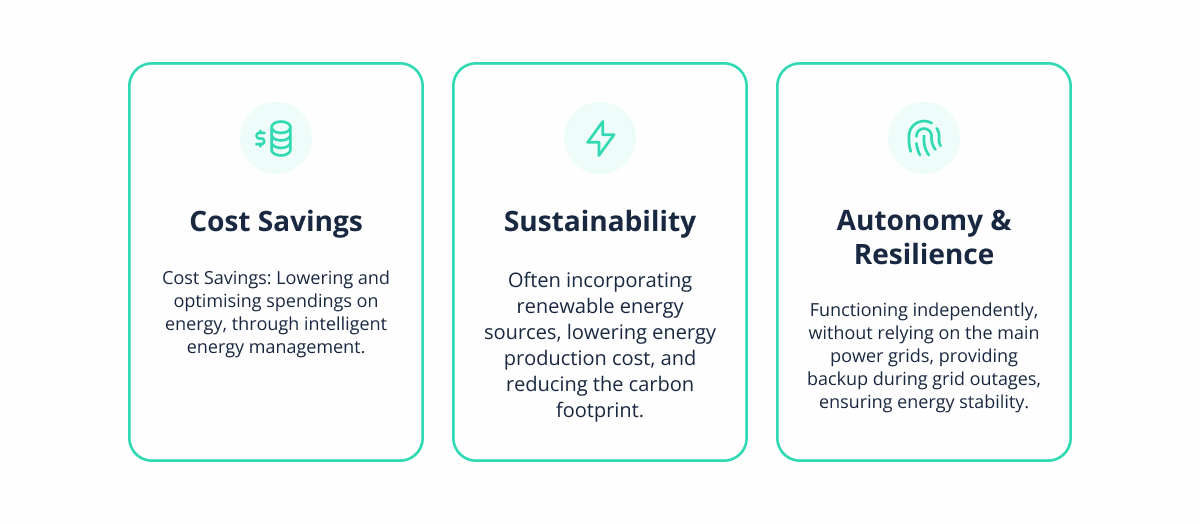Why Microgrids and Distributed Energy Resources (DERs) are Transforming the Energy Landscape
Microgrids are localised energy grids that can operate autonomously from traditional grids. They incorporate DERs, such as solar panels and energy storage systems, to generate and distribute electricity. This development addresses the need for reliable, sustainable, and efficient energy sources. The surge in popularity in relation to DERs and microgrids can be attributed to many different factors. Yet, from a business perspective, it’s clear that autonomy & resilience, sustainability, and cost efficiency are the leading causes for this revolution.
Leading causes for Microgrid implementation:

Decoding the Role of DERs and Software Solutions in Modern Microgrid Technology
The profound importance of Distributed Energy Resources (DERs) within microgrids’ complex architecture must be understood to appreciate and take advantage of their enormous potential fully. The functionality and effectiveness of microgrids are greatly improved by these DERs, which also include solar panels, energy storage systems, and wind turbines. Thanks to their invaluable contributions to energy production, storage, and management, they are firmly established as an integrated and interdependent part of the overall system.
However, using specialized software solutions becomes necessary to utilize microgrids and DERs fully. Working with a seasoned technology partner knowledgeable about microgrids, renewable energy, and DERs can change your life by providing priceless knowledge and experience. Such a technological partner can help design, create, and meticulously fine-tune the technical foundation that drives your energy optimization, microgrid, or DER project to unmatched success.
We’ve supported our customers in the green energy sector by implementing out-of-the-box software solutions and creating bespoke systems. Our primary goal has been to equip these clients with the resources to oversee, regulate, and track their DER assets efficiently. By optimally leveraging their capabilities, microgrids can harness DERs to their full capacity, contributing to a more robust and sustainable energy future and significantly impacting energy efficiency.
It’s crucial to underscore that the success of a microgrid project hinges on thoroughly understanding the role of DERs and implementing suitable software solutions. By engaging with proficient experts and carefully planning DER integration, you can enhance your microgrid’s operation, control, and monitoring, maximizing its benefits for your business and the broader energy ecosystem.

A Guide to Choosing the Right Microgrid Software Solutions
When implementing software solutions for microgrids, there are two distinct paths to consider: utilizing an off-the-shelf solution or engaging an independent contractor to develop a custom software solution. To make an informed decision, it is essential to explore both options:
- Off-the-shelf software solutions are pre-built platforms designed to cater to the needs of microgrids and DER management. These solutions often offer a range of features and functionalities that can be readily implemented. They are typically developed based on industry standards and best practices, offering a plug-and-play approach for microgrid management. Off-the-shelf solutions can be suitable for organizations seeking a quicker and potentially more cost-effective solution, as they eliminate the need for extensive software development.
- Engaging an independent contractor or software development partner allows for creating a tailor-made software solution specific to the unique requirements of your microgrid project. This approach enables you to design a solution from the ground up, ensuring alignment with your organization’s goals, workflows, and integration needs. Customized software development offers the flexibility to incorporate advanced functionalities, integrate with existing systems, and address any specific challenges or complexities within your microgrid.
Off-shelf solutions offer convenience and speed of deployment, while custom software development allows for greater control and adaptability. The choice depends on the project scope, budget, timeline, and specific requirements. A thorough evaluation with the help of an experienced business partner can help you make the right choice.
To ensure that you have the right tools and solutions to maximize your microgrid project’s potential, you need to identify the most suitable path for your software needs, whether it involves utilizing an off-the-shelf solution or embarking on a customized software development journey.
Each microgrid project is unique, and with the right understanding and domain expertise, choosing the right pathway doesn’t have to be a tough choice.
About the author
Connect with Spencer Borison and discover how Codibly can fuel your sustainable transformation:









